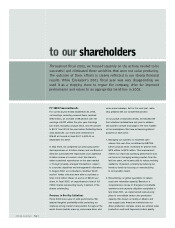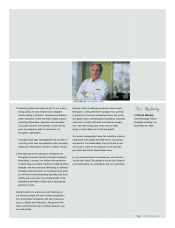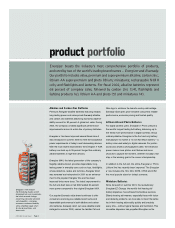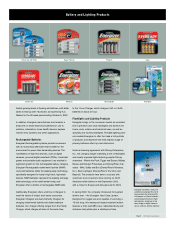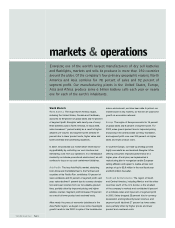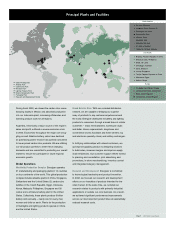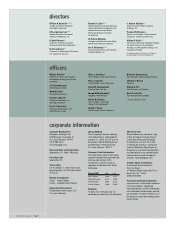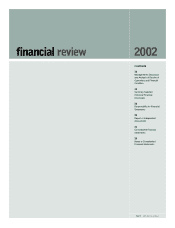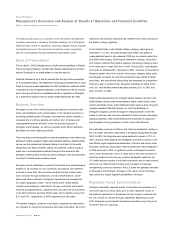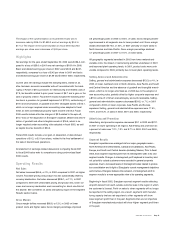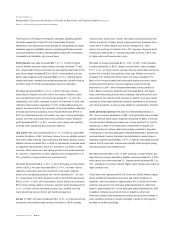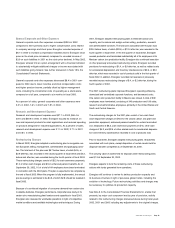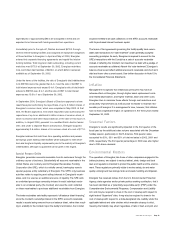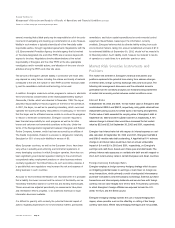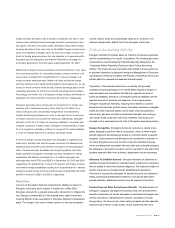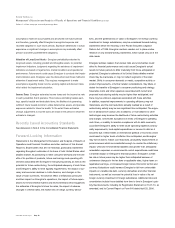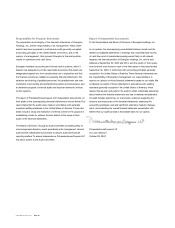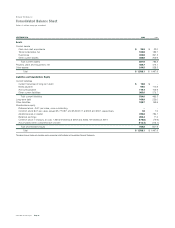Energizer 2002 Annual Report Download - page 14
Download and view the complete annual report
Please find page 14 of the 2002 Energizer annual report below. You can navigate through the pages in the report by either clicking on the pages listed below, or by using the keyword search tool below to find specific information within the annual report.
This structure is the basis for Energizer’s reportable operating segment
information presented in Note 22 to the Consolidated Financial
Statements. Prior periods have been restated for comparability. Energizer
evaluates segment profitability based on operating profit before general
corporate expenses, research and development expenses, amortization
of goodwill and intangibles, and unusual items.
North America
Net sales increased $64.7, or 7%, in 2002 on higher
volume. Alkaline and photo lithium battery unit sales increased 7% and
22%, respectively. Pricing and product mix was slightly unfavorable for the
year. Gross margin increased $75.4 in 2002 on lower product cost and
higher sales. Segment profit increased $83.8, or 41%, reflecting higher
margins and lower overhead and advertising expenses, partially offset by
the $15.0 write-off of Kmart pre-bankruptcy accounts receivable.
Net sales decreased $152.3, or 14%, in 2001 with lower volume
accounting for slightly more than half of the decline. Alkaline, carbon
zinc and lighting products unit volume decreased 5%, 4% and 13%,
respectively, from 2000, compared to heavy Y2K demand in 2000, and
reflecting retail inventory reductions in 2001. Unfavorable pricing and
product mix accounted for the remainder of the sales decline, reflecting
increased promotional spending. Gross margin decreased $118.9 in
2001 on unfavorable pricing and product mix, lower volume and higher
product cost rates associated with lower production levels. Segment
profit decreased $104.1, or 34%, as lower gross margin was partially
offset by lower advertising and promotion expense.
Asia Pacific
Net sales decreased $1.9, or 1%, in 2002 as unfavorable
currency translation of $5.1 and lower volume from non-alkaline product
lines were nearly offset by improved pricing and higher alkaline volume.
Alkaline volume increased 25% in 2002 on significantly increased sales
to equipment manufacturers and a 6% increase in unit sales to retail
channels, while carbon zinc and lighting products unit volume declined
5% and 15%, respectively. In 2002, segment profit increased $11.9, or
18%, primarily on lower product and overhead costs.
Net sales decreased $46.6, or 13%, in 2001. Excluding currency deval-
uation of $30.3, net sales decreased $16.3, or 4%, on lower volume
reflecting unfavorable economic conditions in the region. Alkaline,
carbon zinc and lighting products unit volume decreased 5%, 8% and
2%, respectively, from 2000. Segment profit for Asia Pacific decreased
$20.8, or 24%, in 2001 with unfavorable currency effects accounting for
$19.0 of the decline. Absent currencies, segment profit decreased $1.8,
or 2%, on lower volume and higher product cost, partially offset by
lower advertising and promotion and overhead expenses.
Europe
In 2002, net sales increased $16.0, or 6%, on improved pricing
and product mix and favorable currency translation of $9.9, partially
offset by lower carbon zinc volume. Favorable pricing and product mix
reflects the launch of higher priced, higher performing Energizer Ultra+
in late 2001. In 2002, alkaline unit volume increased 2%, while
carbon zinc continued to decline with a 16% decrease. Segment profit
increased in 2002 by $14.7, including favorable currency of $1.8, due
to higher sales and lower product costs.
Net sales for Europe decreased $13.1, or 5%, in 2001, which included
currency devaluation of $24.2. Absent currency effect, sales increased
$11.1, or 4%, on higher volume, partially offset by unfavorable pricing and
product mix in the first three quarters of the year. Alkaline unit volume
increased 19% during 2001 while carbon zinc volume declined 12%.
Much of the volume increase and unfavorable pricing was due to heavy
promotional activity early in the year. Segment results for Europe
improved $.5 in 2001, which included unfavorable currency effects of
$13.4. Absent currencies, segment profit increased $13.9, with higher
sales, lower advertising and promotion expense, and lower product cost
accounting for the majority of the increase. In addition, prior year results
included an unfavorable adjustment related to estimates for promotional
and rebate programs, as well as costs related to reorganization activities.
South and Central America
Net sales for 2002 decreased $33.3, or
25%, due to currency devaluation of $23.7 and significantly lower volumes,
partially offset by higher prices. Argentina accounted for $26.0 of the total
net sales decline. Alkaline and carbon zinc volume declined 15% and 2%,
respectively, in 2002. In the first quarter of fiscal 2002, Energizer took
deliberate actions to reduce sales and accounts receivable in Argentina
in anticipation of currency devaluation. Following devaluation, demand has
declined sharply, however Energizer has maintained its market share in
Argentina. Segment profit fell $3.6, or 27%, in 2002 as unfavorable currency
impacts of $12.4 and lower volumes were partially offset by higher pricing
and lower product and overhead costs.
Net sales increased $6.9, or 5%, in 2001 primarily on higher volume, par-
tially offset by currency devaluation. Alkaline volume increased 5% in 2001
while carbon zinc volume declined 2%. Segment profit decreased $3.1, or
19%, virtually all on currency impacts. Higher sales volumes were offset by
higher product costs.
Future sales and segment profit for the South and Central America region
will be significantly impacted by economic and market conditions in
Argentina, which accounted for approximately 16% of South and Central
America’s net sales for the fiscal year ended September 30, 2002 com-
pared to approximately 30% for the fiscal year ended September 30, 2001.
In addition, following the economic crisis in Argentina, other Latin
American countries have experienced currency and economic declines. If
such conditions continue to worsen, Energizer’s results for that segment
are likely to decline accordingly.
Energizer Holdings, Inc.
Management’s Discussion and Analysis of Results of Operations and Financial Condition Continued
(Dollars in millions except per share and percentage data)
ENR 2002 Annual Report Page 12


